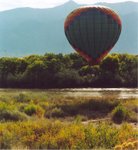The Art of Ballooning
Since all surfaces on Earth absorb the Sun's heat differently, dangerous vertical winds (thermals) emerge as the day progresses. The air is most stable right after sunrise and before sunset. Essentially, the only control a pilot has in a balloon is changing altitude. Pilots usually won’t fly in the middle of the day when that control is lost and when the temperature differential between the outside and the inside of the balloon is too subtle for the balloon to fly in the first place. If you wake early enough on any crisp morning in
 Balloons typically cost between $20,000 - $30,000 and every year some don't fare as well as others. They can catch turbulent or warmer conditions and end up clipping power lines, meeting the "depths" of the Rio Grande, or finding a resting place a lot further away than anticipated. Hence, any experienced balloonist has "chasers" who's sole job is to, well, chase the balloon (usually in a pickup truck). New Mexicans are well acquainted with random trucks driving erratically where no roads could ever possibly go. A word of advice, look up when you see this because there's a good chance your curiosity will be satisfied by the sight of a flying pitcher. Of course, it's also often the case that teenage boredom gets the better of young New Mexican drivers leading to frequent excursions into empty lots. You be the judge.
Balloons typically cost between $20,000 - $30,000 and every year some don't fare as well as others. They can catch turbulent or warmer conditions and end up clipping power lines, meeting the "depths" of the Rio Grande, or finding a resting place a lot further away than anticipated. Hence, any experienced balloonist has "chasers" who's sole job is to, well, chase the balloon (usually in a pickup truck). New Mexicans are well acquainted with random trucks driving erratically where no roads could ever possibly go. A word of advice, look up when you see this because there's a good chance your curiosity will be satisfied by the sight of a flying pitcher. Of course, it's also often the case that teenage boredom gets the better of young New Mexican drivers leading to frequent excursions into empty lots. You be the judge.
The enchantment of ballooning is, for most New Mexicans, far more central than you would expect. We are drawn to the seemingly uncontrollable nature of takeoff, flight, and landing; to the very soothing periodic noise of burners as balloons sail daily overhead; and to the hope that maybe one morning an enormous pig-shaped balloon will drop into our back yard loaded with all sorts of pinata-like goodies.

2 comments:
Great video J!
breakfast burritos at sunrise on the launching field.....yummy!!!
Claudine
Post a Comment